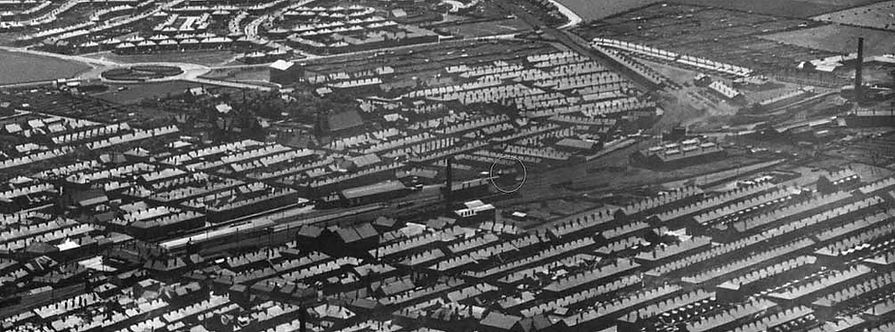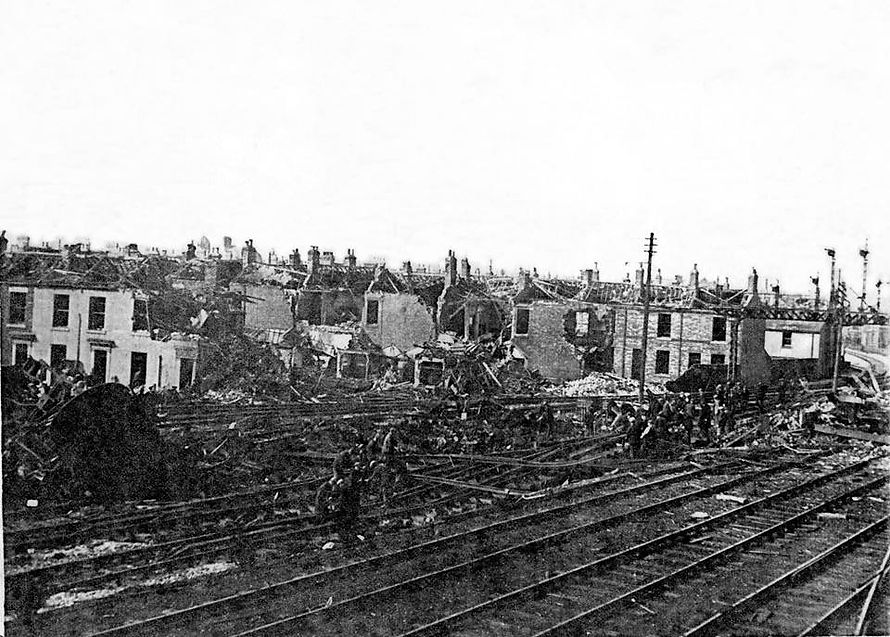
The Night The Bombs Fell.
If you walk along Delaval Terrace, you'll pass Blyth Railway Station's old station master's house. Next you'll come to some blocks of flats that look slightly out of place. They don't seem to fit into the landscape around them, so how did they come to be there?
This area is probably the most visible reminder of the events of the 25th of April 1941.

Of course, The UK had been at war for almost two years at that time and some of our towns and cities had seen relentless bombing by the Luftwaffe. Blyth had escaped the worst of the attacks, possibly because of it's location so far North. Although other nearby towns had been attacked heavily.
Blyth wouldn't be quite so lucky that night.
At the time, Blyth was a hive of industrial activity with coal mines, a thriving port and shipbuilding doing it's part for the war effort. There was also a heavy military presence in the town. A major submarine base was operating in the town and this had attracted military personnel from a number of allied nations.
Wellesley Nautical school was home to the men who were providing support and training to the 6th submarine flotilla which was based in the port.
There as even a prisoner of war camp near Blyth Battery.

The South Harbour just after world war two. Today we know it as the marina but this area was once known as HMS Elfin and almost all Submarine crews between 1941 -1945 would have been trained here.
The wooden huts in the photo were known as The German Huts.
The railway station in the town centre which had sprawling sidings would have been a very tempting target for enemy bombers. In the attack that night the Germans weapon of choice was a parachute mine. So it's possible that the railway station was not the aircrafts actual target.
Parachute mines were designed to explode on land or sink on impact with water and wait for a passing ship to explode. We wont ever know what the aiming point was.
The mine fell on the sidings behind Delaval Terrace next to a signal box, pictured below.
.jpg)

This map from the time shows the streets that used to exist where the flats stand today. You can see how close the signal box (SB) where the mine impacted was to those streets.
The raid took place at 10:30 pm when thankfully less people would have been going about their business and an air raid alarm would have sent many of the local residents to take cover in the Anderson shelters in local gardens and yards.
Of course, this was a manned box and on that night the signalman on duty was John Hollon Elliott Norfolk.
The signal box was completely obliterated and John died instantly. The explosion was so powerful that debris was hurled as far away as Ridley Park.
The surrounding houses were left devastated by the blast and entire streets were demolished.
Another person was also killed in a house in Catherine Terrace which was one of the streets that were completely destroyed that night. Ten people were seriously injured and sixty three suffered less severe injuries.

The grainy image above is the only known photo to have survived of the damage done that night. Most of the buildings on view had to be demolished soon after the raid and there is no sign of the signal box that was hit.
Surprisingly, most of the damage to the railway infrastructure was repaired and the tracks were back in action in under a week.
.jpg)
A 31 year old man who had been retired from the navy due to injuries he received recalls that night in a story in the Blyth News dated 28th April 1941.
He recalls being blown across the room as his house was demolished by the blast, his wife, brother-in-law and a lodger were all buried by the debris but all four were recued uninjured.
Bombs also fell on the town centre that night with damage being done to the church which used to stand in the Market Place, the top half of it's spire was so badly damaged it had to be removed.
Other areas of the town damaged that night included Alexandra Crescent (now part of Renwick Road), Beaumont Street, Bondicar Terrace, Delaval Terrace, Redheads Factory, the makers of confectionery and Maddison Street.

The Zion Methodist Church in the Market Place without the top of its spire after the war.
If you have any information to add to this page, we'd love to hear from you.
You can go to our contact us page by clicking here.
There are also multiple stories about a train wheel which was blown across the town on that night. Many people have written about it but the wheel always seems to land in a different area of the town, depending on who happens to be telling the story.
It may well have happened but an actual witness to the event becomes less likely as time goes by. Or is it possible that the story is an urban legend passing through generations? We probably wont ever know.

A local man "Gerry Evans" wrote a small piece for a project the BBC did on peoples memories of life during the war. He remembers..
Whenever bombs were dropped or planes brought down we always went to see the damage and to collect any ‘souvenirs’ we could find. I remember the time when a dropped bomb resulted in the formation of a crater near to Plessey road. Although this was like a game to us there were times when warfare didn’t seem like fun. For example, when the front of my house was blown off, or when three families who lived near to us were evacuated when their homes were destroyed, or when a local man who worked for the railways died when a wall collapsed on him.
It wasn’t only the events at home that we heard about or witnessed. I remember hearing news from the Front about one of our neighbours, Norman Simpson. The community was shocked to hear of his capture in 1940. He was not released until the end of the war.
Once the Germans surrendered we held mass street parties on VE Day. Eventually we were able to start trying to return to normal, learning to enjoy life without worrying about blackout blinds and air raids. Just being able to go out to the Roxy ballroom for a night out without the fear of air raids hanging over your head was wonderful.
Links
Explore
Advertise
Follow
© 2020/22. blythhub.co.uk | Content Information | Privacy and Cookie Information

